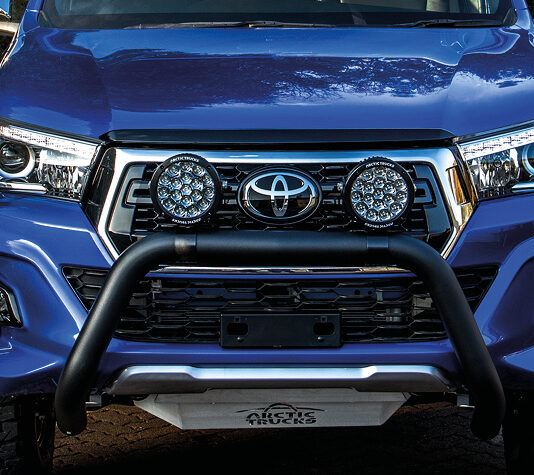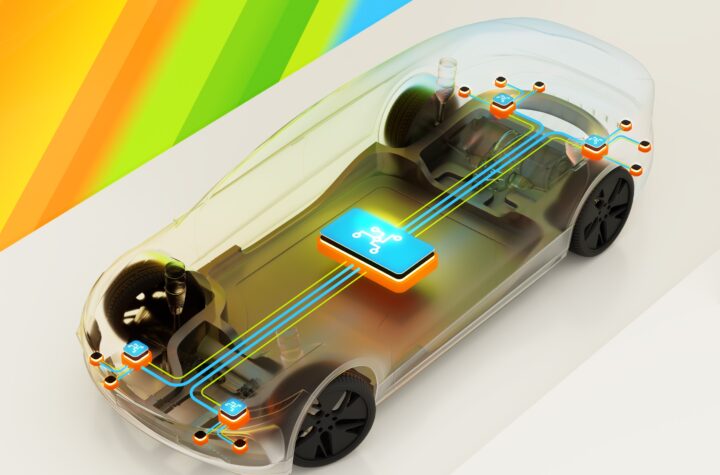
The MOST® Cooperation (MOSTCO) – the standardization organization for the leading automotive multimedia network Media Oriented Systems Transport (MOST) – is showcasing a MOST150 based advanced driver assist system (ADAS) network that transmits HD video streams from up to eight cameras, using up to 1.2 Gbit/s total bandwidth. The surround view cameras are connected to a central node in a star topology over coaxial cable. The multi-channel network approach of MOST, with its inherent synchronicity, is perfectly adapted for ADAS since it assures hard real-time determinism and ultra-low latency at 10 milliseconds; flexible topology; high bandwidth; safety aspects; as well as robustness and maturity. The 360-degree automotive top view system uses small-footprint high dynamic range cameras. The cameras are based on a two-chip solution and, with the remote control feature, no microcontroller is required.
Multiplying Bandwidth to Several MOST150 Branches
A multiport network interface controller in the central node allocates the true, full bandwidth to every branch. The different branches can then be built with any topology, including star, ring, tree or daisy-chain, and can be hot-plugged or disconnected without influencing the flow of streaming data in the rest of the system.
Low Latency Streaming Meets Safety Requirements
Sending a video stream from the camera to the renderer means that a significant amount of data is streamed for a prolonged period of time. Especially with ADAS, the continuously flowing stream of data cannot be interrupted or delayed. MOST provides the transport of data streams with guaranteed bandwidth and latency that the multiplex architecture inherently offers. It does not require either additional communication processors and addressing information, or the bandwidth-wasting process of breaking up the data into packets that then need to be examined every time they go through a device along the route. Complying with safety protocols, MOST delivers video streams with low latency and determinism throughout the system.
Coaxial Cabling Destined for Driver Assist Systems
Using coaxial cable, MOSTCO provides a scalable electrical physical layer for the ADAS automotive domain, as it allows for bidirectional communication and power supply across the same cable. Coaxial cabling is the industry standard cable for transport of high frequency signals. It has inherent shielding and provides low-cost and standard cables and connectors. Its construction enables an automated connector assembly, allowing lower assembly costs than shielded twisted pairs of copper wires (STP). Depending on bandwidth and cable/connector quality, it offers low reflections at up to 100 meters distance. The coaxial standard already works up to several Gbit/s and thus delivers an EMC-proof and low-cost electrical physical layer.
Words: 435
Images
Preview: http://www.alvacon.com/en/news/most-cooperation-20131114-adas-surround-view/
Image 1: MOST150 star topology enables advanced driver assist systems
Copyright: www.mostcooperation.com
Download: http://www.alvacon.com/media/images/MOST150-ADAS-surround-view-star-coax-.jpg
Image 2: Surround view demo system based on MOST150 coaxial cabling
Copyright: www.mostcooperation.com
Download: http://www.alvacon.com/media/images/MOST150-ADAS-surround-view-star-coax-demo-.jpg
About MOST Technology
MOST (Media Oriented Systems Transport) is a multimedia networking technology optimized for use in cars and other applications. It enables the transport of high Quality of Service audio and video together with packet data and real-time control over a single transmission medium. MOST can use plastic optical fibers (POF), coax based electrical physical layer, and shielded and unshielded twisted pair (STP/UTP) copper wires that meet automotive environmental requirements. Today, MOST is used in over 150 car models as the communication backbone for their information and entertainment equipment.
About MOST Cooperation
The MOST Cooperation (MOSTCO) is the organization through which MOST Technology is standardized and refined so that it continues to stay abreast of the latest industry requirements. Today it consists of 16 international carmakers and more than 60 key component suppliers. They have joined together to work with the MOST Technology and to contribute to its innovation. The MOST Cooperation is prepared to embrace efforts to further develop and standardize the technology for other industries and to establish the corresponding work structures. The MOST Cooperation was founded in 1998 to standardize MOST Technology as a global standard for multimedia networking. Audi, BMW, Daimler, HARMAN and Microchip Technology are its core partners and constitute its Steering Committee. For more information see http://www.mostcooperation.com.












More Stories
Cybord TCI – The Future of Manufacturing Integrity
Claas Bracklo on CharIN’s Global Standards Drive for Seamless, Universal EV Charging Systems and Future Innovations in Interoperability
NXP accelerates the development of software defined vehicles with new family of Ethernet switches